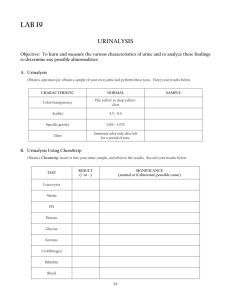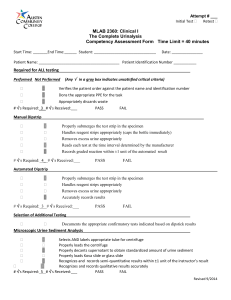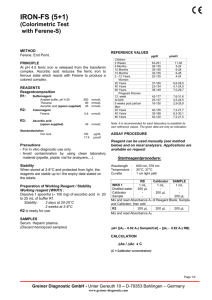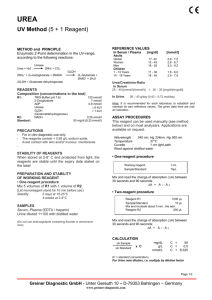Urine sticks 11 parameters. 100 STRIPS.
advertisement
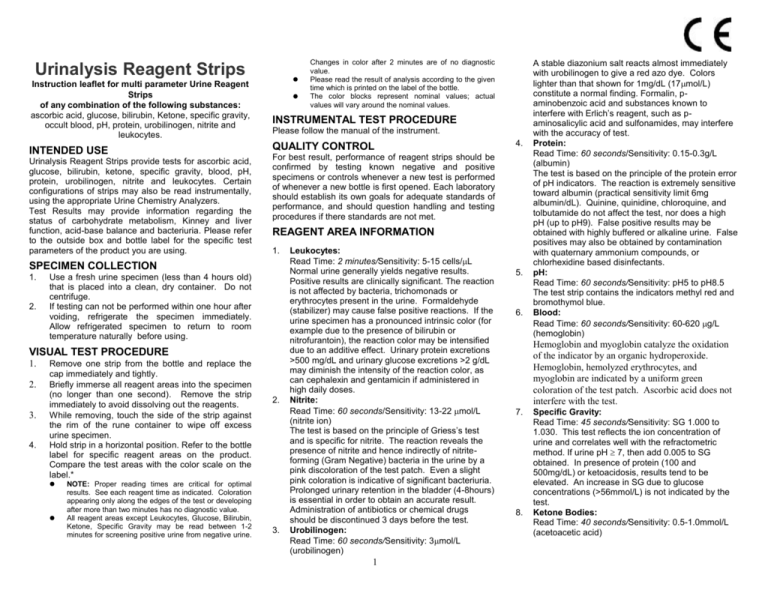
Urinalysis Reagent Strips Instruction leaflet for multi parameter Urine Reagent Strips of any combination of the following substances: ascorbic acid, glucose, bilirubin, Ketone, specific gravity, occult blood, pH, protein, urobilinogen, nitrite and leukocytes. INTENDED USE Urinalysis Reagent Strips provide tests for ascorbic acid, glucose, bilirubin, ketone, specific gravity, blood, pH, protein, urobilinogen, nitrite and leukocytes. Certain configurations of strips may also be read instrumentally, using the appropriate Urine Chemistry Analyzers. Test Results may provide information regarding the status of carbohydrate metabolism, Kinney and liver function, acid-base balance and bacteriuria. Please refer to the outside box and bottle label for the specific test parameters of the product you are using. INSTRUMENTAL TEST PROCEDURE Please follow the manual of the instrument. QUALITY CONTROL 2. REAGENT AREA INFORMATION 1. Use a fresh urine specimen (less than 4 hours old) that is placed into a clean, dry container. Do not centrifuge. If testing can not be performed within one hour after voiding, refrigerate the specimen immediately. Allow refrigerated specimen to return to room temperature naturally before using. VISUAL TEST PROCEDURE 1. 2. 3. 4. Remove one strip from the bottle and replace the cap immediately and tightly. Briefly immerse all reagent areas into the specimen (no longer than one second). Remove the strip immediately to avoid dissolving out the reagents. While removing, touch the side of the strip against the rim of the rune container to wipe off excess urine specimen. Hold strip in a horizontal position. Refer to the bottle label for specific reagent areas on the product. Compare the test areas with the color scale on the label.* NOTE: Proper reading times are critical for optimal results. See each reagent time as indicated. Coloration appearing only along the edges of the test or developing after more than two minutes has no diagnostic value. All reagent areas except Leukocytes, Glucose, Bilirubin, Ketone, Specific Gravity may be read between 1-2 minutes for screening positive urine from negative urine. 4. For best result, performance of reagent strips should be confirmed by testing known negative and positive specimens or controls whenever a new test is performed of whenever a new bottle is first opened. Each laboratory should establish its own goals for adequate standards of performance, and should question handling and testing procedures if there standards are not met. SPECIMEN COLLECTION 1. Changes in color after 2 minutes are of no diagnostic value. Please read the result of analysis according to the given time which is printed on the label of the bottle. The color blocks represent nominal values; actual values will vary around the nominal values. 2. 3. Leukocytes: Read Time: 2 minutes/Sensitivity: 5-15 cells/L Normal urine generally yields negative results. Positive results are clinically significant. The reaction is not affected by bacteria, trichomonads or erythrocytes present in the urine. Formaldehyde (stabilizer) may cause false positive reactions. If the urine specimen has a pronounced intrinsic color (for example due to the presence of bilirubin or nitrofurantoin), the reaction color may be intensified due to an additive effect. Urinary protein excretions >500 mg/dL and urinary glucose excretions >2 g/dL may diminish the intensity of the reaction color, as can cephalexin and gentamicin if administered in high daily doses. Nitrite: Read Time: 60 seconds/Sensitivity: 13-22 mol/L (nitrite ion) The test is based on the principle of Griess’s test and is specific for nitrite. The reaction reveals the presence of nitrite and hence indirectly of nitriteforming (Gram Negative) bacteria in the urine by a pink discoloration of the test patch. Even a slight pink coloration is indicative of significant bacteriuria. Prolonged urinary retention in the bladder (4-8hours) is essential in order to obtain an accurate result. Administration of antibiotics or chemical drugs should be discontinued 3 days before the test. Urobilinogen: Read Time: 60 seconds/Sensitivity: 3mol/L (urobilinogen) 1 5. 6. A stable diazonium salt reacts almost immediately with urobilinogen to give a red azo dye. Colors lighter than that shown for 1mg/dL (17mol/L) constitute a normal finding. Formalin, paminobenzoic acid and substances known to interfere with Erlich’s reagent, such as paminosalicylic acid and sulfonamides, may interfere with the accuracy of test. Protein: Read Time: 60 seconds/Sensitivity: 0.15-0.3g/L (albumin) The test is based on the principle of the protein error of pH indicators. The reaction is extremely sensitive toward albumin (practical sensitivity limit 6mg albumin/dL). Quinine, quinidine, chloroquine, and tolbutamide do not affect the test, nor does a high pH (up to pH9). False positive results may be obtained with highly buffered or alkaline urine. False positives may also be obtained by contamination with quaternary ammonium compounds, or chlorhexidine based disinfectants. pH: Read Time: 60 seconds/Sensitivity: pH5 to pH8.5 The test strip contains the indicators methyl red and bromothymol blue. Blood: Read Time: 60 seconds/Sensitivity: 60-620 g/L (hemoglobin) Hemoglobin and myoglobin catalyze the oxidation of the indicator by an organic hydroperoxide. Hemoglobin, hemolyzed erythrocytes, and myoglobin are indicated by a uniform green coloration of the test patch. Ascorbic acid does not interfere with the test. 7. 8. Specific Gravity: Read Time: 45 seconds/Sensitivity: SG 1.000 to 1.030. This test reflects the ion concentration of urine and correlates well with the refractometric method. If urine pH 7, then add 0.005 to SG obtained. In presence of protein (100 and 500mg/dL) or ketoacidosis, results tend to be elevated. An increase in SG due to glucose concentrations (>56mmol/L) is not indicated by the test. Ketone Bodies: Read Time: 40 seconds/Sensitivity: 0.5-1.0mmol/L (acetoacetic acid) Based on the principle of Legal’s test, this test reacts with acetoacetic acid in urine. It does not react with acetone or -hydroxybutyric acid. Normal urine specimens usually yield negative results, however, detectable levels may be observed during physiological stress conditions such as fasting, pregnancy and frequent strenuous exercise. Captopril, Mesna (sodium 2-mercapto-ethane sulfonate) and other substances containing sulfhydryl groups may produce false-positive results. 9. Bilirubin: Read Time: 30 seconds/Sensitivity: 7-14mol/L (bilirubin) The test for bilirubin is based on the coupling of bilirubin with a diazonium salt. Normally no bilirubin is detected in the urine even by the most sensitive methods. The slightest discoloration of the reagent area constitutes a positive (i.e. pathologic) result. False negatives may be produced by metabolites of drugs that give a color at low pH or by ascorbic acid concentrations in excess of 1.4mmol/L. Indoxyl sulfate may also interfere with the interpretation of a negative or positive bilirubin reading. 10. Glucose: Read Time: 30 seconds/Sensitivity: 4-7mmol/L (glucose) This test is based on the specific glucoseoxidase/peroxidase reaction. It is independent of pH and not affected by presence of ketone bodies. Test reactivity, however, decreases as the SG of the urine increases. Reactivity may also vary with temperature. 11. Ascorbic acid: Read time: 60 seconds/ Sensitivity: 0.6mmol/L This test is based on the principle of Tillman’s reagent. Ascorbic acid can reduce indicator and cause color changing, from blue into red. This test can be used to determine ascorbic acid concentration in sample and decide ascorbic acid ‘s interference. Urobilinogen: 0.4% w/w pdiethylaminobenzaldehyde; 99.6% w/w nonreactive ingredients Protein: 0.2% w/w tetrabromphenol blue; 97.4% w/w buffer; 2.4% w/w nonreactive ingredients pH: 0.2% w/w methyl red; 2.8% w/w bromthymol blue; 97.0% w/w nonreactive ingredients Blood: 6% w/w cumen hydroperoxide; 4% w/w 3,3’,5,5’-tetramethylbenzidine; 50% w/w buffer; 40% w/w non-reactive ingredients Specific Gravity: 1% w/w bromthymol blue; 99% buffer Ketones: 5% w/w sodium nitroprusside; 95% w/w buffer Bilirubin: 0.4% w/w p-chloroaniline diazonium salt; 50% w/w buffer; 49.6% w/w nonreactive ingredients Glucose: 2% w/w glucose oxidase; 1% w/w peroxidase; 10% w/w potassium iodide; 70% w/w buffer; 17% w/w nonreactive ingredients Ascorbic acid: 1% 2,6-dichrophenol-indophenole; 10% buffer; 89% non-reactive ingredients STORAGE AND STABILITY specific gravity REAGENT COMPOSITION NOTICES Leukocytes: 0.5% w/w derivatized thiazoamine acid ester; 0.4% diazonium salt; 50% w/w buffer; 49.1% w/w nonreactive ingredients Nitrite: 1.5% w/w p-sulfanilic acid; 1.5% w/w N-(1Naphthyl)Ethylenediamine; 97% nonreactive ingredients Store at temperature range of 2 to 30C Store out of direct sunlight. PRECAUTION Don’t store the samples for long time (4 hours or longer) before testing. SENSATIVITY and RANGE of TEST Reagent Region ascorbic acid bilirubin Blood (hemoglobin) (Erythrocyte) Glucose ketone leukocytes nitrite pH protein urobilinogen Sensitivity 0.3-0.6 mmol/L 3.3-8.6 umol/L 150-450 ug/L 5-15 cells/uL 2.8-5.5 mmol/L 0.5-1.0 mmol/L 5-15 cells/uL 13-22 umol/L 0.15-0.3 g/L Range of instrumental method 0-2.8 mmol/L 0-110 umol/L 0-6000 ug/L 0-200 cells/uL 0-110 mmol/L 0-7.8 mmol/L 0-500 cells/uL -~+ 5.0-9.0 0-3.0 g/L 1.005-1.030 3.2-16 umol/L 3.2-128 umol/L Range of Visual Method 0-2.8 mmol/L 0-110 umol/L 0-6000 ug/L 0-200 cells/uL 0-110 mmol/L 0-7.8 mmol/L 0-500 cells/uL -~+ 5.0-8.5 0-20.0 g/L 1.0001.030 3.2-128 umol/L For in vitro diagnostic use only. The test device should not be reused. Do not use after expiration date. Do not use after expiration date. Don’t remove the desiccant from bottle; Don’t touch test areas of the urine reagent strips; Don’t open container until ready to perform the assay; The use of urine preservatives can prevent the decomposition of Ketone, bilirubin and urobilinogen in the urine. 2

